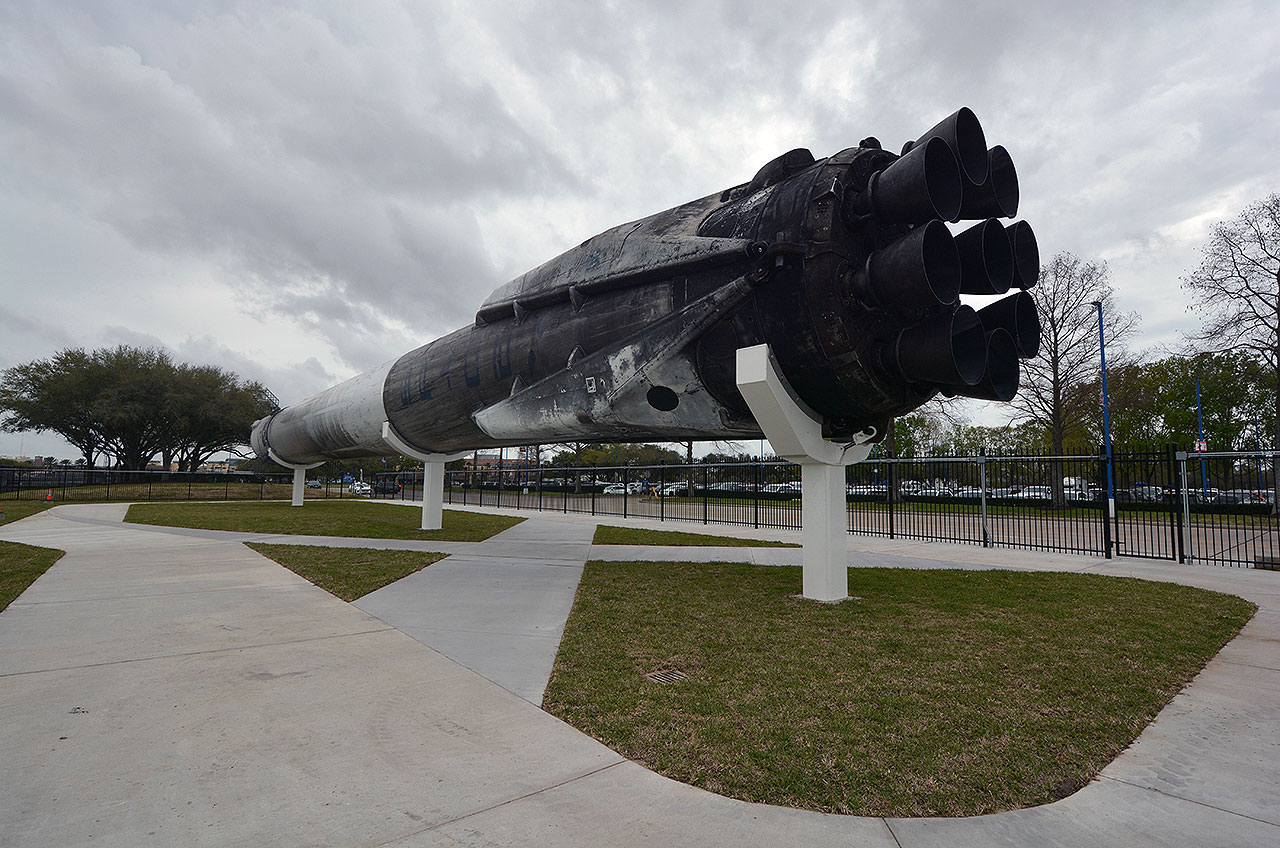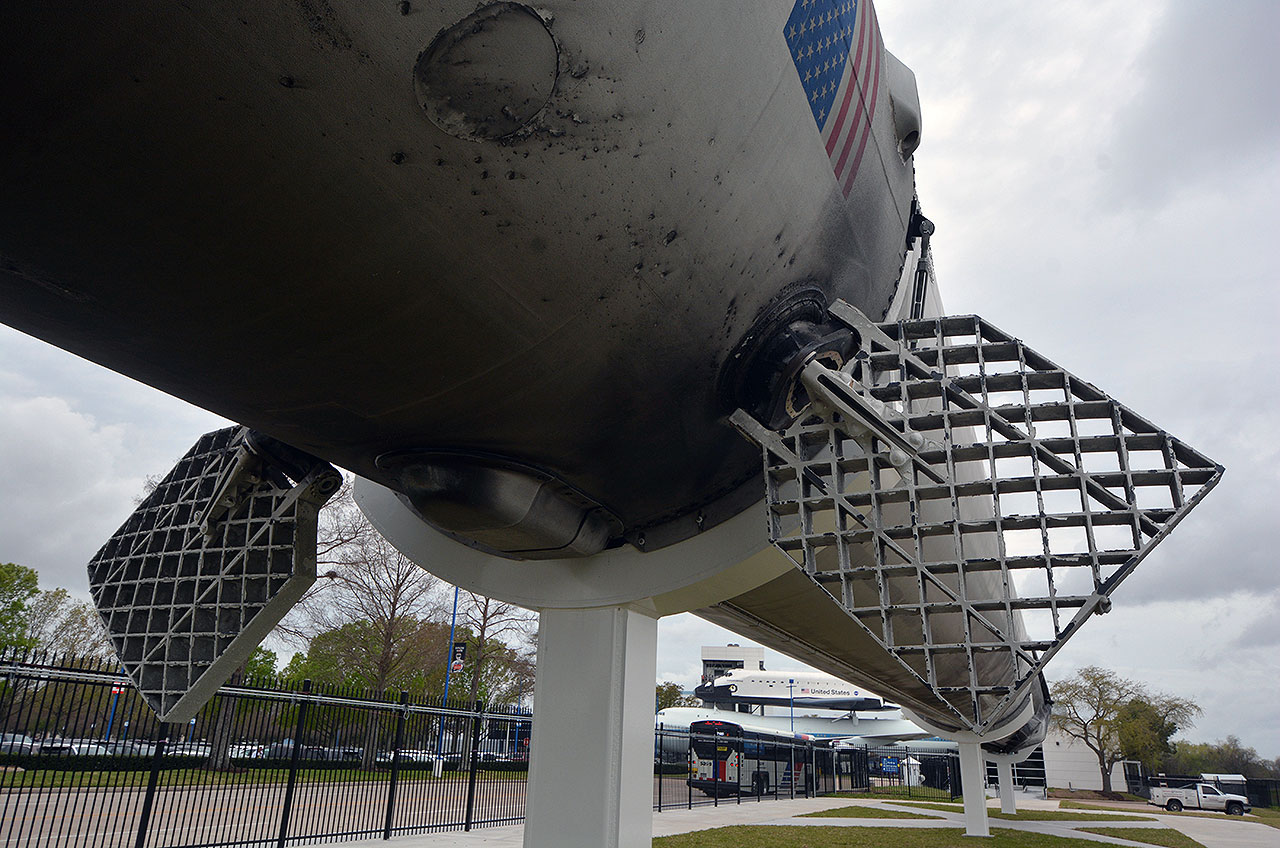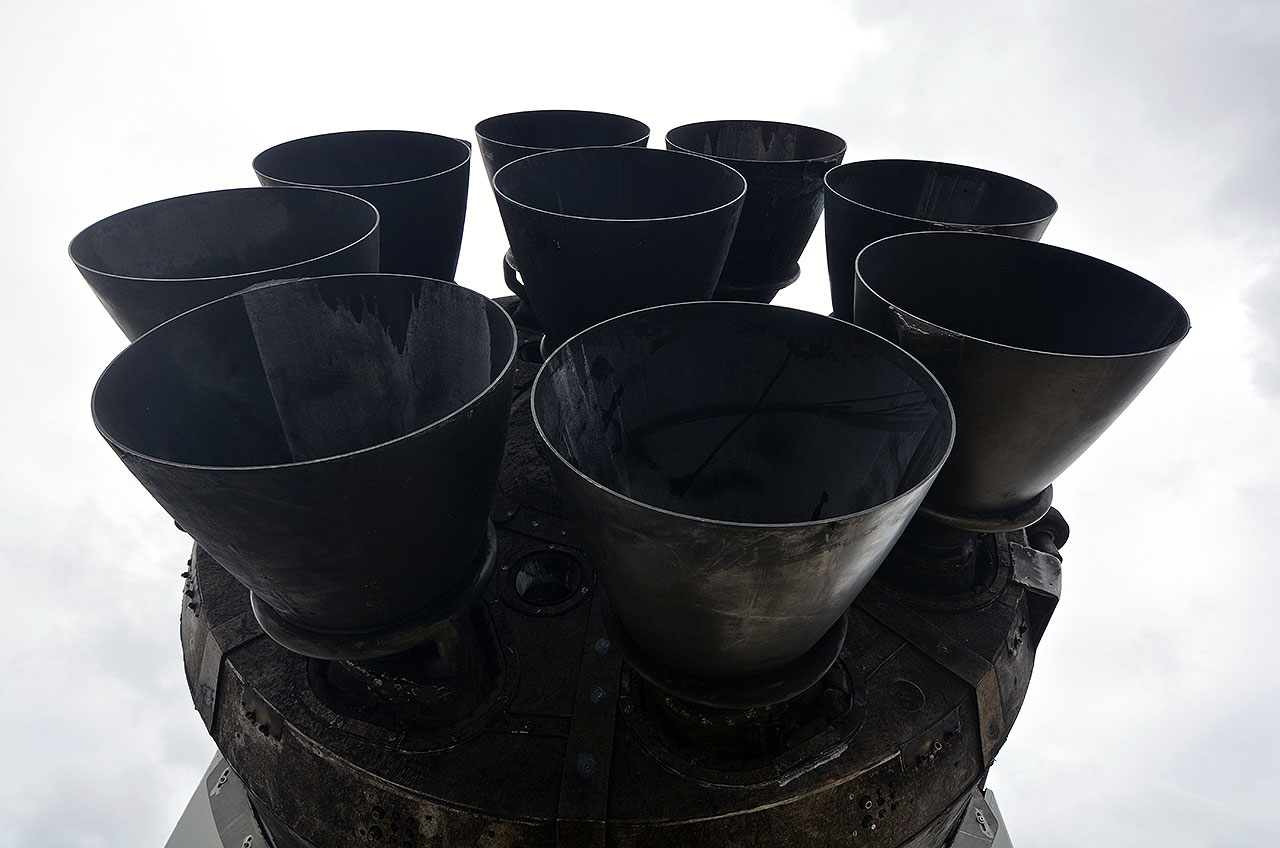SpaceX Falcon 9 rocket debuts on display at Space Center Houston

You can now get up close, around and even under the first-ever commercial rocket to launch on two missions for NASA.
Space Center Houston, the visitor center for NASA's Johnson Space Center in Texas, is welcoming the public to see its newest exhibit — a "flight proven" SpaceX Falcon 9 booster. The rocket's first stage, still displaying the scorch and soot marks from its two launches, has been elevated off the ground and exhibited horizontally, affording a first-of-its-type view of a commercial spaceflight artifact.
"Our SpaceX rocket exhibit will inspire people of all ages to pursue science learning and discovery," William Harris, president and CEO of Space Center Houston, said in a statement. "We want everyone to have access to learn about the growing commercial space sector which is stimulating the economy and drawing more companies to provide innovative technologies, medical advances and further NASA's plans to send humans to the moon and Mars."
Related: See the evolution of SpaceX's rockets in pictures

The outdoor exhibit is set to open to the public at 11 a.m. EST (1500 GMT) on Thursday (March 12), following a ribbon cutting with Space Center Houston and SpaceX officials.
Delivered to Space Center Houston from its Cape Canaveral, Florida launch site on March 4, the rocket was configured and positioned for display by some of the same SpaceX engineers whose work it is to service the recovered Falcon 9 first stages between launches.
"They were so excited to be part of this," Paul Spana, Space Center Houston's exhibits manager, said in an interview with collectSPACE.com. "Because they see it as being historic."
Get the Space.com Newsletter
Breaking space news, the latest updates on rocket launches, skywatching events and more!
"SpaceX refers to it as a 'monument.' I've never used that word, but that is the only word they use," Spana said.
One of only two such "monuments" currently in existence — the first was erected vertically outside of SpaceX's headquarters in Hawthorne, California in 2016 — the Space Center Houston Falcon 9 exhibit is the first to invite the public to walk under the 156-foot-long (47.7-meter) rocket. A concrete walkway was designed to cross under the booster in the shape of the stylized "X" in SpaceX's logo.
Three Y-shaped cradles support the rocket 14 feet (4 m) above the ground.
The Falcon 9 first stage, referred to by SpaceX by its production number, B1035, first lifted off on June 3, 2017, lofting SpaceX's 11th NASA-contracted resupply run to the International Space Station on what was the 100th launch from the space agency's historic Complex 39A at Kennedy Space Center in Florida. The flight also marked the first reuse of a SpaceX Dragon cargo spacecraft.
Related: See awesome photos of SpaceX's Dragon launch and rocket landing
The stage then returned for a propulsive touchdown on SpaceX's Landing Zone-1 (LZ-1) at the nearby Cape Canaveral Air Force Station.
Six months later on Dec. 15, 2017, the first stage was launched again, this time with the space station-bound CRS-13 Dragon capsule. It then landed for a second and last time on LZ-1.
SpaceX subsequently made improvements to the Falcon 9 design, leading to the B1035 stage being retired and available for donation to Space Center Houston. The booster remained intact though, almost to the point that it could be serviced and flown again.
"One of the technicians told me, 'What you got here is a fully functional rocket.' He said this is the real thing and everything is here," said Spana.
The Falcon's four landing legs are missing their actuators and one was flown on a different vehicle than B1035, but the four aluminum grid fins and nine Merlin 1D engines are intact as they were used in flight.

"SpaceX took a lot of steps for preservation," said Spana. "If you look close, you will see fresh silicone here and there and that is to weatherproof it."
Guests visiting Space Center Houston will first see the Falcon 9 display as they enter into the parking lot. They will then access the exhibit by entering the main building (with admission) and then walking out through Independence Plaza, which showcases NASA's original Boeing 747 Shuttle Carrier Aircraft and mock space shuttle orbiter.
Eventually, Space Center Houston plans to erect a new building near the Falcon 9 exhibit to display other commercial spaceflight artifacts.
"I am excited that Space Center Houston has grown to the point where we have exciting things like this coming," said Spana. "I'm really proud that SpaceX worked with us as the first location for a Falcon 9 museum display."
Click through to collectSPACE to see more photos of the Falcon 9 rocket stage display.
- SpaceX launches cargo toward space station, aces 50th rocket landing
- SpaceX aims to launch 70 missions a year from Florida's Space Coast by 2023
- SpaceX Falcon 9 rocket will launch private moon lander in 2021
Follow collectSPACE.com on Facebook and on Twitter at @collectSPACE. Copyright 2020 collectSPACE.com. All rights reserved.
OFFER: Save at least 56% with our latest magazine deal!
All About Space magazine takes you on an awe-inspiring journey through our solar system and beyond, from the amazing technology and spacecraft that enables humanity to venture into orbit, to the complexities of space science.
Join our Space Forums to keep talking space on the latest missions, night sky and more! And if you have a news tip, correction or comment, let us know at: community@space.com.

Robert Pearlman is a space historian, journalist and the founder and editor of collectSPACE.com, a daily news publication and community devoted to space history with a particular focus on how and where space exploration intersects with pop culture. Pearlman is also a contributing writer for Space.com and co-author of "Space Stations: The Art, Science, and Reality of Working in Space” published by Smithsonian Books in 2018.In 2009, he was inducted into the U.S. Space Camp Hall of Fame in Huntsville, Alabama. In 2021, he was honored by the American Astronautical Society with the Ordway Award for Sustained Excellence in Spaceflight History. In 2023, the National Space Club Florida Committee recognized Pearlman with the Kolcum News and Communications Award for excellence in telling the space story along the Space Coast and throughout the world.











